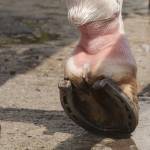Hoof Dressings: Helpful, Harmful, or Humbug?

Find the page displaying hoof dressings in any horse equipment catalog, read the claims for the various preparations, and you may wonder how horses have managed to survive without the oils, herbs, and other mystical substances in every can.
Descriptions of benefits to be derived from hoof dressings begin with generalities:
- Helps restore hoof moisture.
- Aids elasticity.
- Restores and conditions damaged hooves.
Some expanded claims promise more results:
- Prevents brittle hooves.
- Stimulates circulation and promotes new growth.
- Improves hoof strength.
The most boastful descriptions strain credibility:
- Prevents bacterial and fungal conditions in the hoof.
- Helps in treatment of sole and stone bruises, hoof rot, scratches, and dew poisoning.
- Treats calluses, split hooves, corns, quarter cracks, and hard, dry, tender, or contracted feet.
Research has been conducted to find out whether the use of dressings has any impact, good or bad, on the hoof. A study at the University of Edinburgh examined the passage of moisture into and out of the hoof capsule. Researchers tested full-thickness samples from wall, sole, and frog tissues obtained from equine cadavers. The samples were taken from hooves in good condition (solid, no cracks) and in poor condition (visible cracks). In the samples from hooves in good condition, moisture penetrated less than a millimeter into any tissue. Samples from hooves in poor condition allowed much more penetration of moisture into and throughout the inner tissues of the hoof. These results indicate that there is a natural moisture barrier in healthy hoof tissue, and products claiming to moisturize the hoof can be expected to provide little benefit to hooves in good condition.
Some hoof preparations promise to add protein to the hoof. A study at Texas A&M University that investigated the effect of immersion in water found hoof tissues lost chlorine, potassium, and sodium, but protein was not lost. The study concluded that protein is not able to cross cell membranes in the hoof and therefore cannot be absorbed from an external dressing.
Another study at Texas A&M University tested the effects of three different hoof care products on hoof strength and flexibility. Each horse in the study had a dressing applied to three of its hooves while the fourth hoof served as a control. When samples of the hooves were tested after 13 weeks, no differences in strength or flexibility were found between treated and untreated hooves.
The ingredients in some hoof dressings can actually be harmful, excessively drying the outer hoof layers and leading to brittle tissue that can easily develop small cracks. Formalin, solvents, or tar-based products are ingredients with the potential to damage the outer layers of hoof horn. Such damage allows moisture to move in and out of the hoof more freely than in hooves with healthy outer horn. Lower strength has been measured in hoof tissue that is either too dry or too moist, so tampering with the natural moisture level is not thought to be advantageous. In addition, dirt and bacteria may enter the cracks, possibly causing infection.
Some hoof problems are genetic and therefore can’t be prevented. In most other cases, the best way to ensure healthy hooves is to provide balanced nutrition. Protein, calcium, iodine, zinc, iron, manganese, biotin, methionine, and other nutrients play vital roles in tissue growth and health. A properly formulated diet will contain the correct amounts and proportions of protein, vitamins, and minerals to allow normal development and maintenance of all body structures. Feeding the inside of the horse has proven to be a more effective management strategy than applying hoof dressing to the outside of the hooves.
Management practices can also impact hoof condition. Studies of the influence of waste products on hoof tissue show that prolonged exposure to manure caused degradation of horn that was in less than perfect condition. Stalls should be cleaned often enough to prevent horses from standing in soiled bedding for long periods of time. Proper farrier care (trimming hooves and resetting shoes every four to six weeks) is also important in maintaining healthy hooves, as unbalanced feet and long toes increase strain and can lead to chipping and cracking. A third management factor is exercise. Movement stimulates blood flow to the legs and feet, assuring a supply of oxygen and nutrients. The flexing and spreading caused by exercise help the hoof maintain its correct shape and avoid conditions like contracted heels. Staying on schedule with stall cleaning, farrier visits, and exercise will contribute more to hoof health than the daily application of creams and dressings.
Bottom line: Although some horse owners swear by externally applied hoof products, research has failed to support many of the claims made by hoof dressing manufacturers. The hoof is designed to maintain an optimum moisture level and can be harmed by products that cause the outer horny layer to become too dry or too soft. For growth and maintenance of healthy hooves, balanced nutrition and attention to proper management (regular stall cleaning, farrier care, and exercise) are the best guarantees.








